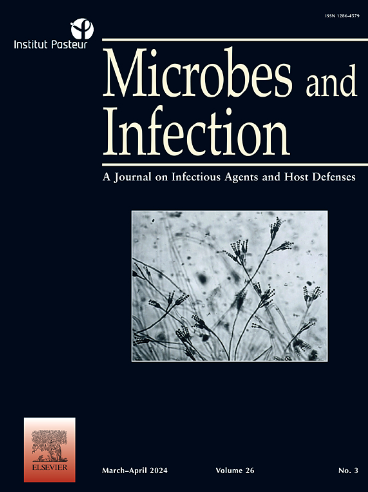光动力疗法降低了巴西孢子虫的活力,增强了伊曲康唑的活性,并损害了线粒体的生理机能。
IF 2.7
4区 医学
Q3 IMMUNOLOGY
引用次数: 0
摘要
巴西孢子丝菌(Sporothrix brasiliensis)是巴西孢子丝菌病的主要病原体,治疗方法很少。本研究旨在探讨使用二极管激光器(InGaAIP)结合光敏剂亚甲基蓝对巴西孢子丝菌酵母进行光动力疗法的体外疗效。此外,我们还评估了尚未充分探索的巴西酵母菌线粒体活性以及激光治疗对治疗后真菌线粒体方面的影响。我们使用了三种 S. brasiliensis 菌株,包括一种对伊曲康唑不耐受的非野生型菌株。通过计数菌落形成单位来确定酵母的活力。为了全面分析辐照与非辐照细胞,我们评估了伊曲康唑联合疗法、细胞扫描电子显微镜和线粒体活性。后者包括高分辨率呼吸测定、膜电位分析和活性氧生成。亚甲蓝与光动力疗法相结合抑制了分离菌株的生长,包括对伊曲康唑的非野生型菌株。光动力疗法诱导产生活性氧,对线粒体功能产生负面影响,导致膜电位降低和细胞死亡。光动力疗法改变了巴西孢子虫的超微结构和线粒体生理机能,为治疗该物种引起的孢子丝虫病提供了一种新的治疗方法。本文章由计算机程序翻译,如有差异,请以英文原文为准。

Photodynamic therapy reduces viability, enhances itraconazole activity, and impairs mitochondrial physiology of Sporothrix brasiliensis
Sporothrix brasiliensis is the main agent of sporotrichosis in Brazil, with few therapeutic options. This study aimed to investigate the in vitro efficacy of photodynamic therapy using a diode laser (InGaAIP) in combination with the photosensitizer methylene blue against S. brasiliensis yeasts. Additionally, we evaluated the underexplored mitochondrial activity of S. brasiliensis and the impact of laser treatment on the fungal mitochondrial aspects post-treatment. Three strains of S. brasiliensis were used, including a non-wild-type strain to itraconazole. Yeast viability was determined by counting colony-forming units. For a comprehensive analysis of irradiated versus non-irradiated cells, we assessed combined therapy with itraconazole, scanning electron microscopy of cells, and mitochondrial activity. The latter included high-resolution respirometry, membrane potential analysis, and reactive oxygen species production. Methylene blue combined with photodynamic therapy inhibited the growth of the isolates, including the non-wild-type strain to itraconazole. Photodynamic therapy induced the production of reactive oxygen species, which negatively affected mitochondrial function, resulting in decreased membrane potential and cell death. Photodynamic therapy altered the ultrastructure and mitochondrial physiology of S. brasiliensis, suggesting a new therapeutic approach for sporotrichosis caused by this species.
求助全文
通过发布文献求助,成功后即可免费获取论文全文。
去求助
来源期刊

Microbes and Infection
医学-病毒学
CiteScore
12.60
自引率
1.70%
发文量
90
审稿时长
40 days
期刊介绍:
Microbes and Infection publishes 10 peer-reviewed issues per year in all fields of infection and immunity, covering the different levels of host-microbe interactions, and in particular:
the molecular biology and cell biology of the crosstalk between hosts (human and model organisms) and microbes (viruses, bacteria, parasites and fungi), including molecular virulence and evasion mechanisms.
the immune response to infection, including pathogenesis and host susceptibility.
emerging human infectious diseases.
systems immunology.
molecular epidemiology/genetics of host pathogen interactions.
microbiota and host "interactions".
vaccine development, including novel strategies and adjuvants.
Clinical studies, accounts of clinical trials and biomarker studies in infectious diseases are within the scope of the journal.
Microbes and Infection publishes articles on human pathogens or pathogens of model systems. However, articles on other microbes can be published if they contribute to our understanding of basic mechanisms of host-pathogen interactions. Purely descriptive and preliminary studies are discouraged.
 求助内容:
求助内容: 应助结果提醒方式:
应助结果提醒方式:


